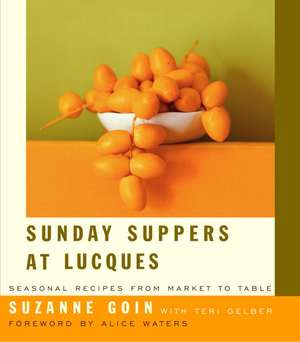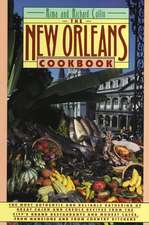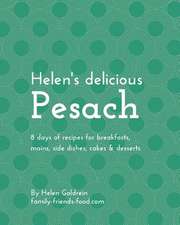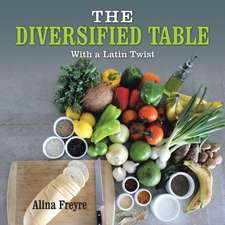Sunday Suppers at Lucques: Seasonal Recipes from Market to Table
Autor Suzanne Goin Fotografii de Shimon & Tammar Teri Gelberen Limba Engleză Hardback – 31 oct 2005
Vezi toate premiile Carte premiată
James Beard Foundation Book Awards (2006), IACP Crystal Whisk Award (2006)
And come they have, in droves. Since opening her L.A. restaurant, Lucques, in 1998, Goin’s cooking has garnered extraordinary accolades. Lucques is now recognized as one of the best restaurants in the country, and she is widely acknowledged as one of the most talented chefs around. Goin’s gospel is her commitment to the freshest ingredients available; her way of combining those ingredients in novel but impeccably appropriate ways continues to awe those who dine at her restaurant.
Her Sunday Supper menus at Lucques–ever changing and always tied to the produce of the season–have drawn raves from all quarters: critics, fellow chefs, and Lucques’s devoted clientele. Now, in her long-awaited cookbook, Sunday Suppers at Lucques, Goin offers the general public, for the first time, the menus that have made her famous.
This inspired cookbook contains:
§132 recipes in all, arranged into four-course menus and organized by season. Each recipes contains detailed instructions that distill the creation of these elegant and classy dishes down to easy-to-follow steps. Recipes include: Braised Beef Shortribs with Potato Puree and Horseradish Cream; Cranberry Walnut Clafoutis; Warm Crepes with Lemon Zest and Hazelnut Brown Butter
§75 full-color photographs that illustrate not only the beauty of the food but the graceful plating techniques that Suzanne Goin is known for
§A wealth of information on seasonal produce–everything from reading a ripe squash to making the most of its flavors. She even tells us where to purchase the best fruit, vegetables, and pantry items
§Detailed instruction on standard cooking techniques both simple and involved, from making breadcrumbs to grilling duck
§A foreword by Alice Waters, owner and head chef of Chez Panisse restaurant and mentor to Suzanne Goin (one-time Chez Panisse line cook)
With this book, Goin gives readers a sublime collection of destined-to-be-classic recipes. More than that, however, she offers advice on how home cooks can truly enjoy the process of cooking and make that process their own. One Sunday with Suzanne Goin is guaranteed to change your approach to cooking–not to mention transform your results in the kitchen.
Preț: 325.10 lei
Nou
Puncte Express: 488
Preț estimativ în valută:
62.21€ • 64.95$ • 51.48£
62.21€ • 64.95$ • 51.48£
Carte disponibilă
Livrare economică 14-28 martie
Preluare comenzi: 021 569.72.76
Specificații
ISBN-13: 9781400042159
ISBN-10: 1400042151
Pagini: 398
Ilustrații: 75 4-C PHOTOS THROUGHOUT
Dimensiuni: 209 x 241 x 30 mm
Greutate: 1.38 kg
Editura: ALFRED A KNOPF
Locul publicării:New York, NY
ISBN-10: 1400042151
Pagini: 398
Ilustrații: 75 4-C PHOTOS THROUGHOUT
Dimensiuni: 209 x 241 x 30 mm
Greutate: 1.38 kg
Editura: ALFRED A KNOPF
Locul publicării:New York, NY
Notă biografică
Suzanne Goin graduated from Brown University. She was named Best Creative Chef by Boston magazine in 1994, one of the Best New Chefs by Food & Wine in 1999, and was nominated for a James Beard Award in 2003, 2004, and 2005. She and her business partner, Caroline Styne, also run the restaurant A.O.C. in Los Angeles, where Goin lives with her husband, David Lentz.
Teri Gelber is a food writer and public-radio producer living in Los Angeles.
Teri Gelber is a food writer and public-radio producer living in Los Angeles.
Extras
Only on St. Patrick's Day is it imperative that both your ice cream and your cake contain beer. Not your typical chocolate cake, this chocolate-stout cake has an unexpected kick to it. The addition of molasses, cloves, cinnamon, and nutmeg steers it into the spice cake category, with chocolate undertones and an undefinable depth from the dark, full-bodied stout.
For me, the biggest surprise of this dessert is the Guinness ice cream. I'm a vanilla girl all the way, and when chefs use weird ingredients just for the sake of being different, I usually pass. But here the dark beer flavor really works in the ice cream to complement the cake. A touch spicy, it might just cure a hangover.
Chocolate Stout Cake
Ingredients
2 cups all-purpose flour
3/4 cup unsweetened cocoa powder
1 1/2 teaspoons baking powder
1/2 teaspoon ground cloves
1/2 teaspoon ground cinnamon
1/2 teaspoon freshly ground nutmeg
1 cup Guinness stout
1 cup molasses
1 1/2 teaspoons baking soda
3 extra-large eggs
1/2 cup dark-brown sugar
1/2 cup granulated sugar
1 cup vegetable oil
1 teaspoon unsalted butter, softened
1. Preheat the oven to 350° F.
2. Sift the flour, cocoa powder, baking powder, cloves, cinnamon, and nutmeg together in a large mixing bowl.
3. Pour the beer and molasses into a medium pot, whisk together, and bring to a boil over medium-high heat. Remove from the heat, and whisk in the baking soda. Don't be surprised when it foams up.
4. In another bowl, whisk together the eggs and both sugars, mixing well to combine. Whisk in the oil, and then the beer mixture.
5. Make a well in the center of the dry ingredients. Pour in the liquid ingredients, whisking slowly until just incorporated. Be careful not to overmix or the cake will be tough.
6. Pour the batter into a lightly buttered Bundt pan and bake 30 minutes. The cake is done when it begins to pull away from the sides of the pan and the top surface is just starting to crack. When you insert a skewer into the center, it should come out mostly clean. To keep the cake moist, cover it with a dry kitchen towel as it cools. After 30 minutes, invert the cake onto a platter.
7. Serve slices of the cake with scoops of the Guinness ice cream.
Guinness ice cream
Ingredients
1/2 vanilla bean
1 cup whole milk
1 cup heavy cream
2/3 cup Guinness stout
2 tablespoons plus 2 teaspoons molasses
3 extra-large egg yolks
1/3 cup granulated sugar
1/2 teaspoon pure vanilla extract
Guinness Ice Cream
1. Split the vanilla bean in half lengthwise. Using a paring knife, scrape the seeds and pulp into a medium saucepan. Add the vanilla pod, milk, and cream, and bring to a boil over medium heat. Turn off the heat, cover, and allow the flavors to infuse for 30 minutes.
2. While the cream is infusing, whisk the beer and molasses together in a small saucepan, bring to a boil, and then turn off the heat.
3. Whisk the egg yolks, sugar, and vanilla extract together in a bowl. Whisk a few tablespoons of the warm cream mixture into the yolks to temper them. Slowly, add another ¼ cup or so of the warm cream, whisking continuously. At this point you can add the rest of the cream mixture in a slow, steady stream, whisking continuously. Pour the mixture back into the pot, and return to the stove.
4. Stir the beer mixture into the cream and cook the custard over medium heat, 6 to 8 minutes, stirring frequently with a rubber spatula and scraping the bottom and sides of the pan. The custard will thicken and when it's done will coat the back of the spatula. Strain the mixture, and chill at least 2 hours in the refrigerator. When the custard is very cold, process it in an ice cream maker according to the manufacturer's instructions.
Caramelized Bread Pudding with Chocolate and Cinnamon
This recipe is a lifer. I’ve been making it for more than 20 years, and every time I try to file it away, someone inevitably comes along asking for it. I brought it to my first staff get-together when I was working at Chez Panisse and, from then on, for all of the parties that followed, when I would even think of making something different, my friends and coworkers would cry out for this caramelized chocolate bread pudding. A few years later, the bread pudding gained an East Coast fan club, too. I was working at Alloro, a tiny restaurant in Boston’s Italian district. Back then, the Mafia owned all the local cafés and had a monopoly on the dessert-and-coffee crowd. Whereas the other (probably wiser) restaurants on the street obeyed the unspoken law of not selling dessert, at Alloro we broke the rule and secretly served this bread pudding to our in-the-know customers. We worked hard to keep the highly requested dessert under cover, and it seems we succeeded: both the recipe and I are still around.
A few things make this bread pudding better than most. I love custards and am often disappointed by bread puddings with too much bread and not enough pudding. So be careful to use just a single layer of brioche, which creates a crispy crust but won’t absorb all the rich, silky custard underneath. Once you break through the caramelized, toasty top layer and dig down through the luscious custard, a treasure of melted chocolate awaits you at the bottom.
2 tablespoons unsalted butter, softened
4 or 5 slices brioche, or good quality white bread (I like Pepperidge Farm), 1/4-inch thick, crusts removed
3 extra-large eggs
2 extra-large egg yolks
1/4 cup brown sugar
1 1/2 cups heavy cream
1 1/4 cups whole milk
1 teaspoon pure vanilla extract
1/2 teaspoon ground cinnamon
1/4 teaspoon freshly grated nutmeg
1/4 teaspoon kosher salt
3/4 cup chopped bittersweet chocolate
1 tablespoon granulated sugar, for caramelizing the top
Preheat the oven to 350°F. Spread the softened butter on one side of the brioche. Cut each slice in half on the diagonal and then again into quarters.
Whisk together the eggs, egg yolks, and brown sugar in a large bowl. Add the cream, milk, vanilla, cinnamon, nutmeg, and salt, whisking to combine well.
Sprinkle the chocolate over the bottom of a 9-by-9-inch (or equivalent) baking dish. Arrange the brioche, buttered side up, with slices overlapping just slightly, on the chocolate (there should be just a single layer of bread). Pour the custard over the bread, pressing down with your fingers to make sure the bread soaks it up. Place the bread pudding in a roasting pan, and pour warm water into the pan to come halfway up the sides of the pudding dish. Bake about 1 hour and 15 minutes, until the custard is set and the bread puffs up slightly. The pudding will be springy to the touch.
Let the bread pudding cool at least 10 minutes.
If you have a kitchen blowtorch, sprinkle the sugar over the top, and torch to brown and caramelize. You could run the pudding under the broiler to caramelize if you don’t have a torch, but be careful not to curdle the custard underneath. Serve the bread pudding from the baking dish at the table, using a big spoon.
Sautéed Halibut with Arugula, Roasted Beets, and Horseradish Crème Fraîche
The colored beets and bright green arugula in this dish make for a visually stunning presentation. The sweet roasted beets marinated in lemon vinaigrette play off the pure white fish and horseradish cream. Look for a few different types of beets, such as golden beets and Chioggia beets, and dress them separately, so the dark ones don’t bleed their juices onto the lighter ones. In the spring, you could make this dish with wild salmon.
NOTE
Season the fish with lemon zest and herbs, roast the beets, and make the vinaigrette and horseradish cream in advance. When it’s time for dinner, all you’ll have to do is sauté the fish and dress the beets.
6 halibut fillets, 5 to 6 ounces each
1 lemon, zested
1 tablespoon thyme leaves
2 tablespoons coarsely chopped flat-leaf parsley
2 tablespoons extra-virgin olive oil
4 ounces arugula, cleaned
Roasted beets with horseradish crème fraîche (recipe follows)
2 tablespoons super-good extra-virgin olive oil, for drizzling
Kosher salt and freshly ground black pepper
Season the fish with the lemon zest, thyme, and parsley. Cover, and refrigerate at least 4 hours or overnight.
Remove the fish from the refrigerator 15 minutes before cooking, to bring it to room temperature.
Heat a large sauté pan over high heat for 2 minutes. (Depending on the size of your pan, you may need to cook the fish in batches or in two pans.) Season the fish on both sides with salt and pepper. Swirl the regular extra-virgin olive oil into the pan and wait 1 minute. Carefully lay the fish in the pan, and cook 3 to 4 minutes, until it’s lightly browned. Turn the fish over, lower the heat to medium-low, and cook a few more minutes, until it’s almost cooked through. Be careful not to overcook the fish. When it’s done, the fish will begin to flake and separate a little, and the center will still be slightly translucent. Remember, the halibut will continue to cook for a bit once you take it out of the pan.
Scatter half of the arugula over a large platter. Arrange the beets on top, and drizzle with half the horseradish cream. Tuck the rest of the arugula among the beets, so you can see the beets peeking through. Nestle the fish in the salad, and spoon a little horseradish cream over each piece. Drizzle the whole dish with the super-good olive oil and a big squeeze of lemon.
Roasted Beets with Horseradish Crème Fraîche
4 bunches different-colored beets
1/2 cup plus 2 tablespoons extra-virgin olive oil
1 tablespoon diced shallot, plus 1/4 cup sliced shallots
1 tablespoon plus 1 teaspoon balsamic vinegar
2 tablespoons red wine vinegar
2 1/2 teaspoons lemon juice
1/2 cup creme fraiche
1 tablespoon prepared horseradish
1/4 cup heavy cream
Kosher salt and freshly ground black pepper
Preheat the oven to 400°F.
Cut off the beet greens, leaving 1/2 inch of the stems still attached. (You can save the leaves for sauteing later—they are delicious!) Clean the beets well, and toss them with 2 tablespoons olive oil and 1 teaspoon salt.
Place the beets in a roasting pan with a splash of water in the bottom. Cover the pan tightly with foil, and roast for about 40 minutes, until they’re tender when pierced. (The roasting time will depend on the size and type of beet.) When the beets are done, carefully remove the foil. Let cool, and peel the beets by slipping off the skins with your fingers. Cut them into 1/2-inch-thick wedges.
While the beets are in the oven, combine the diced shallot, both vinegars, 2 teaspoons lemon juice, and 1/4 teaspoon salt in a small bowl, and let sit 5 minutes. Whisk in the 1/2 cup olive oil. Taste for balance and seasoning.
Whisk the crème fraîche and horseradish together in a small bowl. Stir in the heavy cream, remaining 1/2 teaspoon lemon juice, 1/8 teaspoon salt, and a pinch of pepper.
Toss the beets and sliced shallots with the vinaigrette. (If you’re using different-colored beets, dress each color in a separate bowl so the colors don’t bleed.) Season with 1/4 teaspoon salt and a pinch of freshly ground black pepper, and toss well. Taste for balance and seasoning.
For me, the biggest surprise of this dessert is the Guinness ice cream. I'm a vanilla girl all the way, and when chefs use weird ingredients just for the sake of being different, I usually pass. But here the dark beer flavor really works in the ice cream to complement the cake. A touch spicy, it might just cure a hangover.
Chocolate Stout Cake
Ingredients
2 cups all-purpose flour
3/4 cup unsweetened cocoa powder
1 1/2 teaspoons baking powder
1/2 teaspoon ground cloves
1/2 teaspoon ground cinnamon
1/2 teaspoon freshly ground nutmeg
1 cup Guinness stout
1 cup molasses
1 1/2 teaspoons baking soda
3 extra-large eggs
1/2 cup dark-brown sugar
1/2 cup granulated sugar
1 cup vegetable oil
1 teaspoon unsalted butter, softened
1. Preheat the oven to 350° F.
2. Sift the flour, cocoa powder, baking powder, cloves, cinnamon, and nutmeg together in a large mixing bowl.
3. Pour the beer and molasses into a medium pot, whisk together, and bring to a boil over medium-high heat. Remove from the heat, and whisk in the baking soda. Don't be surprised when it foams up.
4. In another bowl, whisk together the eggs and both sugars, mixing well to combine. Whisk in the oil, and then the beer mixture.
5. Make a well in the center of the dry ingredients. Pour in the liquid ingredients, whisking slowly until just incorporated. Be careful not to overmix or the cake will be tough.
6. Pour the batter into a lightly buttered Bundt pan and bake 30 minutes. The cake is done when it begins to pull away from the sides of the pan and the top surface is just starting to crack. When you insert a skewer into the center, it should come out mostly clean. To keep the cake moist, cover it with a dry kitchen towel as it cools. After 30 minutes, invert the cake onto a platter.
7. Serve slices of the cake with scoops of the Guinness ice cream.
Guinness ice cream
Ingredients
1/2 vanilla bean
1 cup whole milk
1 cup heavy cream
2/3 cup Guinness stout
2 tablespoons plus 2 teaspoons molasses
3 extra-large egg yolks
1/3 cup granulated sugar
1/2 teaspoon pure vanilla extract
Guinness Ice Cream
1. Split the vanilla bean in half lengthwise. Using a paring knife, scrape the seeds and pulp into a medium saucepan. Add the vanilla pod, milk, and cream, and bring to a boil over medium heat. Turn off the heat, cover, and allow the flavors to infuse for 30 minutes.
2. While the cream is infusing, whisk the beer and molasses together in a small saucepan, bring to a boil, and then turn off the heat.
3. Whisk the egg yolks, sugar, and vanilla extract together in a bowl. Whisk a few tablespoons of the warm cream mixture into the yolks to temper them. Slowly, add another ¼ cup or so of the warm cream, whisking continuously. At this point you can add the rest of the cream mixture in a slow, steady stream, whisking continuously. Pour the mixture back into the pot, and return to the stove.
4. Stir the beer mixture into the cream and cook the custard over medium heat, 6 to 8 minutes, stirring frequently with a rubber spatula and scraping the bottom and sides of the pan. The custard will thicken and when it's done will coat the back of the spatula. Strain the mixture, and chill at least 2 hours in the refrigerator. When the custard is very cold, process it in an ice cream maker according to the manufacturer's instructions.
Caramelized Bread Pudding with Chocolate and Cinnamon
This recipe is a lifer. I’ve been making it for more than 20 years, and every time I try to file it away, someone inevitably comes along asking for it. I brought it to my first staff get-together when I was working at Chez Panisse and, from then on, for all of the parties that followed, when I would even think of making something different, my friends and coworkers would cry out for this caramelized chocolate bread pudding. A few years later, the bread pudding gained an East Coast fan club, too. I was working at Alloro, a tiny restaurant in Boston’s Italian district. Back then, the Mafia owned all the local cafés and had a monopoly on the dessert-and-coffee crowd. Whereas the other (probably wiser) restaurants on the street obeyed the unspoken law of not selling dessert, at Alloro we broke the rule and secretly served this bread pudding to our in-the-know customers. We worked hard to keep the highly requested dessert under cover, and it seems we succeeded: both the recipe and I are still around.
A few things make this bread pudding better than most. I love custards and am often disappointed by bread puddings with too much bread and not enough pudding. So be careful to use just a single layer of brioche, which creates a crispy crust but won’t absorb all the rich, silky custard underneath. Once you break through the caramelized, toasty top layer and dig down through the luscious custard, a treasure of melted chocolate awaits you at the bottom.
2 tablespoons unsalted butter, softened
4 or 5 slices brioche, or good quality white bread (I like Pepperidge Farm), 1/4-inch thick, crusts removed
3 extra-large eggs
2 extra-large egg yolks
1/4 cup brown sugar
1 1/2 cups heavy cream
1 1/4 cups whole milk
1 teaspoon pure vanilla extract
1/2 teaspoon ground cinnamon
1/4 teaspoon freshly grated nutmeg
1/4 teaspoon kosher salt
3/4 cup chopped bittersweet chocolate
1 tablespoon granulated sugar, for caramelizing the top
Preheat the oven to 350°F. Spread the softened butter on one side of the brioche. Cut each slice in half on the diagonal and then again into quarters.
Whisk together the eggs, egg yolks, and brown sugar in a large bowl. Add the cream, milk, vanilla, cinnamon, nutmeg, and salt, whisking to combine well.
Sprinkle the chocolate over the bottom of a 9-by-9-inch (or equivalent) baking dish. Arrange the brioche, buttered side up, with slices overlapping just slightly, on the chocolate (there should be just a single layer of bread). Pour the custard over the bread, pressing down with your fingers to make sure the bread soaks it up. Place the bread pudding in a roasting pan, and pour warm water into the pan to come halfway up the sides of the pudding dish. Bake about 1 hour and 15 minutes, until the custard is set and the bread puffs up slightly. The pudding will be springy to the touch.
Let the bread pudding cool at least 10 minutes.
If you have a kitchen blowtorch, sprinkle the sugar over the top, and torch to brown and caramelize. You could run the pudding under the broiler to caramelize if you don’t have a torch, but be careful not to curdle the custard underneath. Serve the bread pudding from the baking dish at the table, using a big spoon.
Sautéed Halibut with Arugula, Roasted Beets, and Horseradish Crème Fraîche
The colored beets and bright green arugula in this dish make for a visually stunning presentation. The sweet roasted beets marinated in lemon vinaigrette play off the pure white fish and horseradish cream. Look for a few different types of beets, such as golden beets and Chioggia beets, and dress them separately, so the dark ones don’t bleed their juices onto the lighter ones. In the spring, you could make this dish with wild salmon.
NOTE
Season the fish with lemon zest and herbs, roast the beets, and make the vinaigrette and horseradish cream in advance. When it’s time for dinner, all you’ll have to do is sauté the fish and dress the beets.
6 halibut fillets, 5 to 6 ounces each
1 lemon, zested
1 tablespoon thyme leaves
2 tablespoons coarsely chopped flat-leaf parsley
2 tablespoons extra-virgin olive oil
4 ounces arugula, cleaned
Roasted beets with horseradish crème fraîche (recipe follows)
2 tablespoons super-good extra-virgin olive oil, for drizzling
Kosher salt and freshly ground black pepper
Season the fish with the lemon zest, thyme, and parsley. Cover, and refrigerate at least 4 hours or overnight.
Remove the fish from the refrigerator 15 minutes before cooking, to bring it to room temperature.
Heat a large sauté pan over high heat for 2 minutes. (Depending on the size of your pan, you may need to cook the fish in batches or in two pans.) Season the fish on both sides with salt and pepper. Swirl the regular extra-virgin olive oil into the pan and wait 1 minute. Carefully lay the fish in the pan, and cook 3 to 4 minutes, until it’s lightly browned. Turn the fish over, lower the heat to medium-low, and cook a few more minutes, until it’s almost cooked through. Be careful not to overcook the fish. When it’s done, the fish will begin to flake and separate a little, and the center will still be slightly translucent. Remember, the halibut will continue to cook for a bit once you take it out of the pan.
Scatter half of the arugula over a large platter. Arrange the beets on top, and drizzle with half the horseradish cream. Tuck the rest of the arugula among the beets, so you can see the beets peeking through. Nestle the fish in the salad, and spoon a little horseradish cream over each piece. Drizzle the whole dish with the super-good olive oil and a big squeeze of lemon.
Roasted Beets with Horseradish Crème Fraîche
4 bunches different-colored beets
1/2 cup plus 2 tablespoons extra-virgin olive oil
1 tablespoon diced shallot, plus 1/4 cup sliced shallots
1 tablespoon plus 1 teaspoon balsamic vinegar
2 tablespoons red wine vinegar
2 1/2 teaspoons lemon juice
1/2 cup creme fraiche
1 tablespoon prepared horseradish
1/4 cup heavy cream
Kosher salt and freshly ground black pepper
Preheat the oven to 400°F.
Cut off the beet greens, leaving 1/2 inch of the stems still attached. (You can save the leaves for sauteing later—they are delicious!) Clean the beets well, and toss them with 2 tablespoons olive oil and 1 teaspoon salt.
Place the beets in a roasting pan with a splash of water in the bottom. Cover the pan tightly with foil, and roast for about 40 minutes, until they’re tender when pierced. (The roasting time will depend on the size and type of beet.) When the beets are done, carefully remove the foil. Let cool, and peel the beets by slipping off the skins with your fingers. Cut them into 1/2-inch-thick wedges.
While the beets are in the oven, combine the diced shallot, both vinegars, 2 teaspoons lemon juice, and 1/4 teaspoon salt in a small bowl, and let sit 5 minutes. Whisk in the 1/2 cup olive oil. Taste for balance and seasoning.
Whisk the crème fraîche and horseradish together in a small bowl. Stir in the heavy cream, remaining 1/2 teaspoon lemon juice, 1/8 teaspoon salt, and a pinch of pepper.
Toss the beets and sliced shallots with the vinaigrette. (If you’re using different-colored beets, dress each color in a separate bowl so the colors don’t bleed.) Season with 1/4 teaspoon salt and a pinch of freshly ground black pepper, and toss well. Taste for balance and seasoning.
Descriere
With 132 seasonal recipes, California chef Goin brings her delectable Sunday suppers into readers' own kitchens. 75 full-color photos.
Premii
- James Beard Foundation Book Awards Winner, 2006
- IACP Crystal Whisk Award Finalist, 2006















